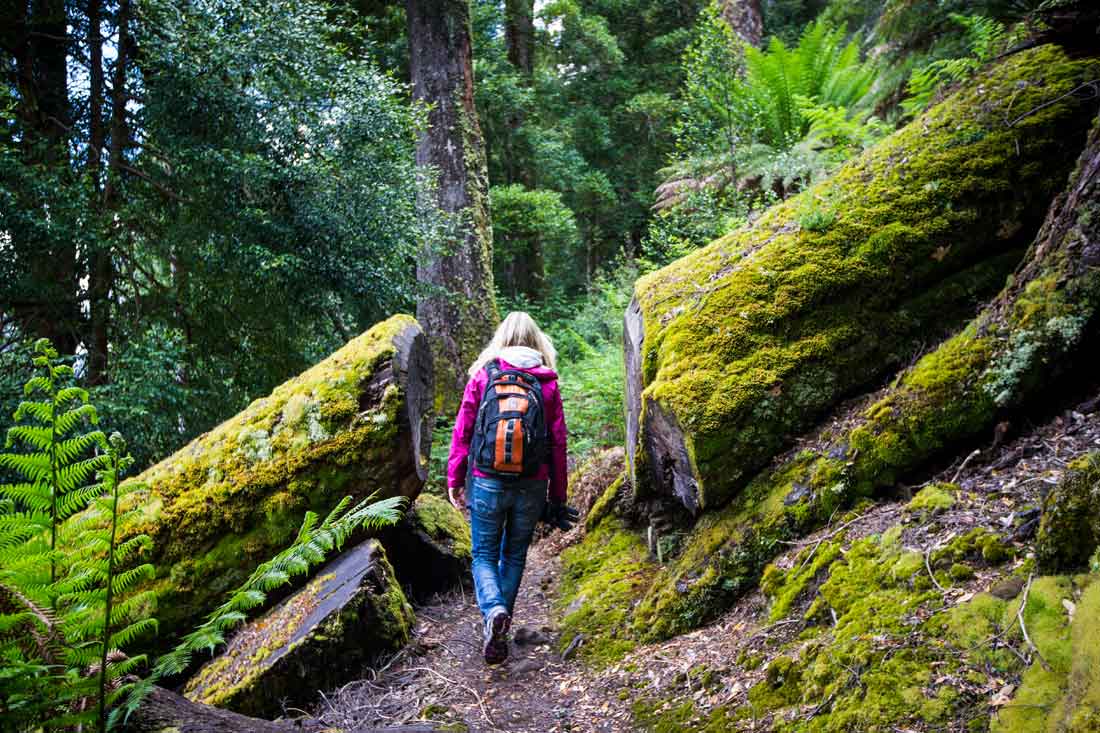We’d only just started our walk, departing Cradle Mountain Lodge and heading out onto one of treks available through the Cradle Mountain – Lake St Clair National Park. I’d just made a comment to my partner about how the surrounds felt like we’d walked onto a Lord of the Rings movie set; the forest around us was so dense, lush and everything, absolutely everything, was covered in bright green moss.
And then I stopped in my tracks. In a burrow, less than an arm’s reach from our path, I saw a flash of teeth. Calling out to my partner who was walking ahead we stopped to watch the small face of a wombat yawn widely before bumbling out of its burrow. The largest wombat I’d ever seen (arguably I have few to compare) walked over our feet and continued along its way, stopping to scratch itself as though we weren’t there at all. It certainly set the standard for our one-day hike through Cradle Mountain and around the Dove Lake Circuit (the most popular day hike for visitors.)

At 1545 meters above sea level, Cradle Mountain and the surrounding region offer up a variety of hikes, allowing adventurers of all experience levels to enjoy the views. From short walks on level terrain to the six-day trek on the famous Overland Track for expert hikers, there’s a hike (and plenty of variety in the scenery) for every ability level. Named for its resemblance to a gold mining cradle, this region has been wowing explorers with its landscape of rugged rocks, rainforest, cascading waterfalls and towering pines. Throw in the abundance of wildlife you’ll see everywhere and it’s a hiker’s dream. Even on a weekend hike in the warmer months, the trails snake through such dense wooded areas you often feel as though you’re completely alone before you find yourself at a large alpine meadow loaded with buttongrass.
RELATED: CHECK OUT OUR SMALL GROUP TOURS THROUGH CRADLE MOUNTAIN
The area is a geological wonderland with its 2 million-year-old glacial lakes and cave systems. It’s also home to Australia’s only deciduous tree (the nothofagus gunnii) but all the science aside, you certainly won’t need a geology or botany degree to appreciate just how fresh and pristine this place is. In fact, the only way to describe it is to quote a fellow hiker in saying “the air just breathes cleaner here.” They’re right, it does.

Depending on the time of year you visit, you can expect a considerable variation in what you experience as well. We hiked in late summer and found the grasslands full of colourful wildflowers, winter brings a more challenging hike with snow, but we’re told it’s worth the effort, and in autumn in winter the landscape is sprinkled with glistening snow and the nothofagus gunnii burst into fiery colours before shedding their leaves.
With the wilderness icon bringing in over 170,000 visitors annually, managing growing visitor numbers has become essential. So much so that the World Heritage destination has been the topic of much discussion in regards to infrastructure development, further improving accessibility for visitors. One proposal on the table is a cable car to provide all weather, and mobility, access to Dove Lake from outside the Park boundaries. The cable car would travel from a new Visitor Centre to a viewing platform and shelter at Dove Lake, relocating the car park and returning it to a minimalist state with only essential vehicle access and a shuttle bus service allowed into the park.


The National Park is approximately 90 minutes’ drive from Devonport and 2.5 hours from Launceston. Arrive at the Ranger’s Station/ Visitors Centre via your own vehicle and take the shuttle bus to access Dove Lake and other day walk areas 7 days a week. Keen to experience some of the shorter walks? You can access these just outside the entry to the National Park, near Cradle Mountain Lodge. The shorter walks range in 20-minute strolls on level terrain (The Enchanted Stroll) to longer treks like The Waterfalls Walk which includes Pencil Pine Falls and Knyvet Falls at 1.5kms. This one’s perfect for getting some great waterfall photography and in warmer months is a popular swimming spot. Alternatively, give yourself a bit more of a challenge and tackle The Speeler Track, with scenery ranging from the brilliant green mossy rainforests to the wide open fields of buttongrass. Rumour has it, and our experience certainly confirmed it, this trek is the ideal one for spotting wombats, wallabies and echidnas.
For someone with a moderate level of fitness, head into the National Park and spend an early morning or afternoon tackling the Dove Canyon trek. You can also access this one via the Waterfalls Walk. Here’s where you’ll encounter the 60-70 metre cliffs that form Dove River and some of the best views you’ll find in the region; and as it’s a 3 hour walk, it’s the perfect way to enjoy the Park in a day. All tracks are clearly marked, so there’s no fear of getting lost.
Want to experience Cradle Mountain with a local guide? Check out our Tasmania small group tours.
Images c/o Tasmania Tourism










